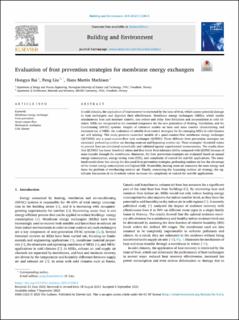| dc.description.abstract | In cold climates, the application of heat recovery is restricted by the issue of frost, which causes potential damage to heat exchangers and degrades their effectiveness. Membrane energy exchangers (MEEs), which enable simultaneous heat and moisture transfer, can reduce and delay frost formation and accumulation in cold climates. MEEs are recognized as the essential component for the new generation of Heating, Ventilation, and Air Conditioning (HVAC) systems. Despite of extensive studies on heat and mass transfer characterising and increased use of MEEs, the evaluation of suitable frost control strategies for the emerging MEEs in cold climates are still missing. This study presents numerical models of a quasi-counter-flow membrane energy exchanger (QCFMEE) and a quasi-counter-flow heat exchanger (QCFHE). Three different frost prevention strategies are examined: preheating outdoor air, heating room air and bypassing outdoor air. These strategies’ threshold values to prevent frost are calculated numerically and validated against experimental measurements. The results show that QCFMEE has lower threshold values and thus better frost tolerance ability compared with QCFHE because of mass transfer through the membranes. Moreover, the frost prevention strategies are evaluated based on annual energy consumption, energy saving ratio (ESR), and complexity of control for real-life applications. The simulated results show that among the discussed frost prevention strategies, preheating outdoor air has the advantage of the lowest energy consumption and highest ESR. Meanwhile, heating room air consumes the most energy and faces the problem of overheating outdoor air. Finally, concerning the bypassing outdoor air strategy, the significant fluctuation of its threshold values increases the complexity of control for real-life applications. | en_US |

